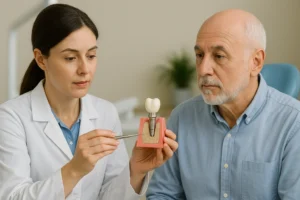Oral cancer is a serious health concern that can affect anyone, regardless of age or lifestyle. Early detection and treatment are crucial in increasing the chances of a successful outcome. In this article, we will discuss the key aspects of oral pathology, focusing on detecting and treating the early signs of oral cancer. Understanding the symptoms and available treatment options can empower individuals to seek timely medical attention and improve their oral health.
Oral pathology is the study of diseases that affect the mouth, jaws, and related structures. It involves the examination of oral tissues to identify any abnormalities that could indicate the presence of disease, such as oral cancer. Dental professionals, including oral pathologists and surgeons, play a vital role in diagnosing and managing these conditions.
Oral Lesions and Their Significance
Oral lesions are abnormal growths or sores that can appear in the mouth. While many oral lesions are harmless, some can be indicative of more serious conditions, including oral cancer. It’s essential to pay attention to any unusual changes in the mouth and seek professional evaluation if needed.
Common Signs of Oral Pathology
Several signs can suggest the presence of oral pathology:
- Persistent sores or ulcers that do not heal
- White or red patches on the gums, tongue, or lining of the mouth
- Unexplained bleeding or pain in the mouth
- Lumps or thickening of tissues in the mouth or neck
- Difficulty swallowing or moving the jaw or tongue
Recognizing these symptoms early can lead to a prompt diagnosis and better treatment outcomes.
Diagnosing Oral Lesions
Diagnosing oral lesions involves a thorough examination by a dental professional. During a dental visit, the dentist will inspect the mouth for any unusual signs and may perform additional tests if necessary.
The Role of Biopsy in Oral Pathology
A biopsy is a critical procedure in diagnosing oral lesions. It involves removing a small sample of tissue from the suspicious area for laboratory analysis. This process helps determine whether the lesion is benign (non-cancerous) or malignant (cancerous).
Biopsies are typically performed by oral surgeons or pathologists and can be done using various techniques, depending on the location and size of the lesion.
Oral Cancer Screening
Routine oral cancer screenings are essential, especially for individuals at higher risk due to factors such as tobacco use, excessive alcohol consumption, or a family history of cancer. During a screening, the dentist will look for signs of oral cancer and may use special tools to enhance visualization of any abnormalities.
Treatment Options for Oral Pathology
Once a diagnosis is confirmed, the treatment plan for oral pathology will depend on the type and stage of the disease.
Surgical Interventions
For malignant lesions, surgical removal is often the first line of treatment. The goal is to excise the cancerous tissue while preserving as much healthy tissue as possible. In some cases, additional surgery may be necessary to ensure complete removal of the cancer.
Radiation and Chemotherapy
In addition to surgery, radiation therapy and chemotherapy may be recommended to destroy any remaining cancer cells and reduce the risk of recurrence. These treatments can be used alone or in combination, depending on the individual case.
Targeted Therapy
Targeted therapy is a newer treatment option that involves using drugs to specifically target cancer cells while minimizing damage to healthy cells. This approach can be particularly effective for certain types of oral cancer and is often used in conjunction with other treatments.
Importance of Early Detection
Early detection of oral cancer significantly improves the chances of successful treatment and recovery. Regular dental check-ups and self-examinations at home are vital in catching any early signs of oral pathology.
Self-Examination Tips
Performing regular self-examinations can help individuals detect any unusual changes in their mouth. Here are some tips:
- Use a mirror and good lighting to inspect all areas of the mouth, including the gums, tongue, and cheeks.
- Look for any color changes, sores, or lumps.
- Pay attention to any new sensations, such as pain or difficulty swallowing.
If you notice any concerning changes, schedule an appointment with your dentist as soon as possible.
Conclusion
Oral pathology plays a crucial role in detecting and treating early signs of oral cancer. By understanding the symptoms and seeking timely medical attention, individuals can take proactive steps in managing their oral health. Regular dental visits, oral cancer screenings, and self-examinations are essential practices in maintaining a healthy mouth and preventing serious complications. Remember, early detection is key to successful treatment and a brighter, healthier future.



